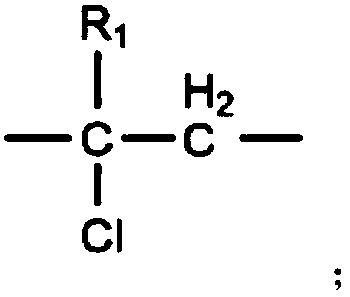Anionic chlorine-containing amphiphilic polymer and preparation method thereof
An amphiphilic polymer and anionic technology, applied in chemical instruments and methods, semi-permeable membrane separation, membranes, etc., can solve the problems that the hydrophilic monomer components cannot be greatly improved, and achieve excellent hydrophilicity and expand The effect of application range
- Summary
- Abstract
- Description
- Claims
- Application Information
AI Technical Summary
Problems solved by technology
Method used
Image
Examples
Embodiment 1
[0095] Synthesis of the anionic chlorine-containing amphiphilic polymer P1 with the chlorine-containing macromolecule dispersant D1 solution as the dispersant:
[0096] Add 100g N, N dimethylacetamide (DMAC), 6g of vinylidene chloride, 5g of acrylic acid, 0.1g of initiator benzoyl peroxide (BPO) into the reactor, dissolve and stir at room temperature for 30 minutes under the condition of nitrogen to remove from the system oxygen. Under the condition of reflux, the temperature was raised to the polymerization temperature of 62° C., and the polymerization reaction was carried out. After 5.5 hours of reaction, the heating was stopped, and air was introduced to terminate the reaction. Obtain chlorine-containing macromolecular dispersant D1 solution. Add 2000ml of deionized water, 1.2g of D1 solution, 1g of bis(2-ethylhexyl) peroxydicarbonate (EHP) into the stainless steel reactor, vacuumize and fill with nitrogen for 3 times, then add 1500g of vinylidene chloride , Solubilizer ...
Embodiment 2
[0102] Chlorine-containing macromolecular dispersant D2 solution is the synthesis of the anionic chlorine-containing amphiphilic polymer P2 of the dispersant:
[0103] The synthesis process of D2 and P2 refers to Example 1, and the formula and process parameters are shown in Table 1 and Table 2 respectively.
[0104] The structure and performance characterization methods of D2 and P2 are the same as those in Example 1. The anionic hydrophilic monomer component content, molecular weight and molecular weight distribution of D2 are shown in Table 3; the anionic hydrophilic monomer component content, molecular weight and molecular weight distribution of P2 are shown in Table 3.
Embodiment 3
[0106] Chlorine-containing macromolecular dispersant D3 solution is the synthesis of the anionic chlorine-containing amphiphilic polymer P3 of the dispersant:
[0107] The synthesis process of D3 and P3 refers to Example 1, and the formula and process parameters are shown in Table 1 and Table 2 respectively.
[0108] The structure and property characterization methods of D3 and P3 are the same as those in Example 1. The anionic hydrophilic monomer component content, molecular weight and molecular weight distribution of D3 are shown in Table 3; the anionic hydrophilic monomer component content, molecular weight and molecular weight distribution of P3 are shown in Table 3.
PUM
| Property | Measurement | Unit |
|---|---|---|
| number average molecular weight | aaaaa | aaaaa |
| number average molecular weight | aaaaa | aaaaa |
| molecular weight distribution | aaaaa | aaaaa |
Abstract
Description
Claims
Application Information
 Login to View More
Login to View More - Generate Ideas
- Intellectual Property
- Life Sciences
- Materials
- Tech Scout
- Unparalleled Data Quality
- Higher Quality Content
- 60% Fewer Hallucinations
Browse by: Latest US Patents, China's latest patents, Technical Efficacy Thesaurus, Application Domain, Technology Topic, Popular Technical Reports.
© 2025 PatSnap. All rights reserved.Legal|Privacy policy|Modern Slavery Act Transparency Statement|Sitemap|About US| Contact US: help@patsnap.com



